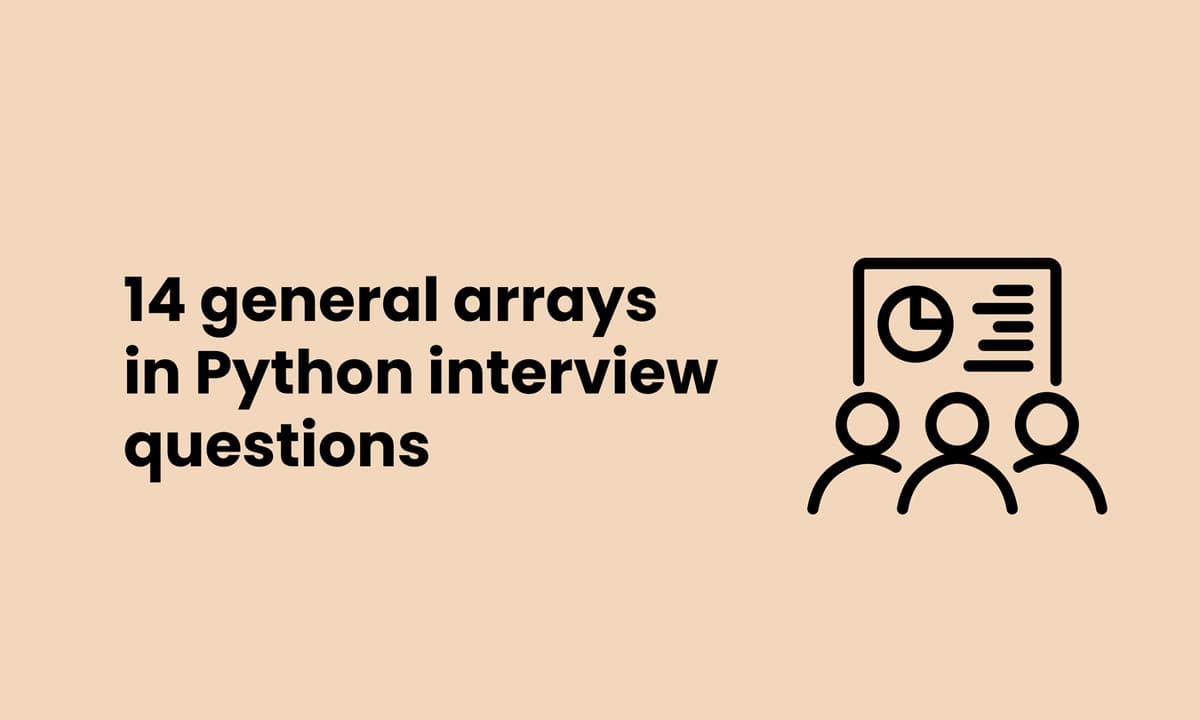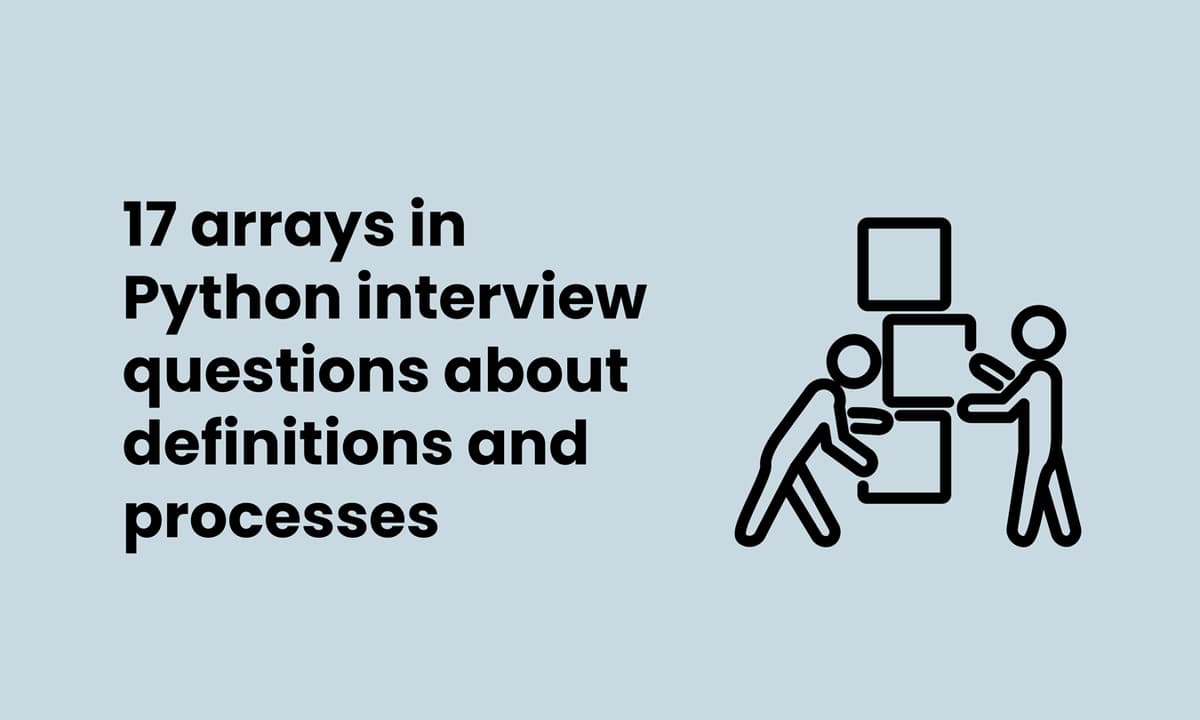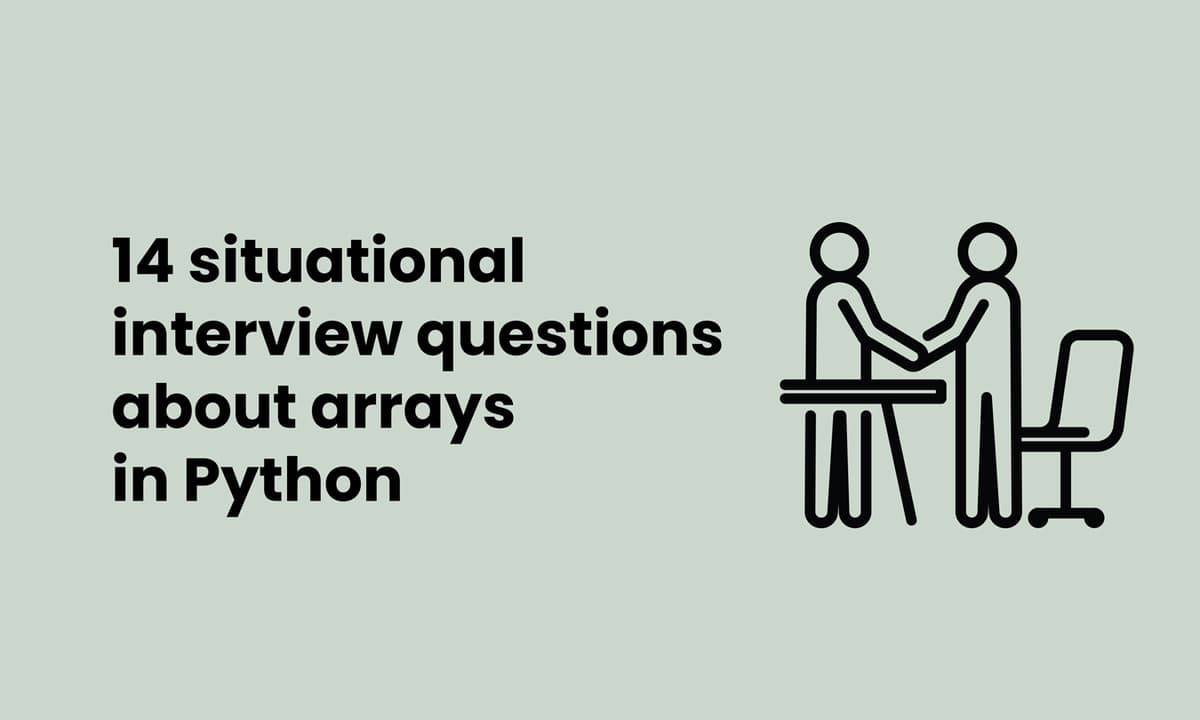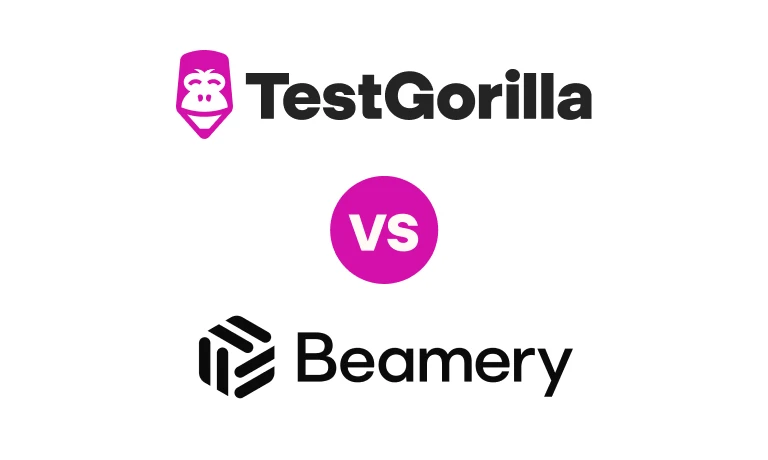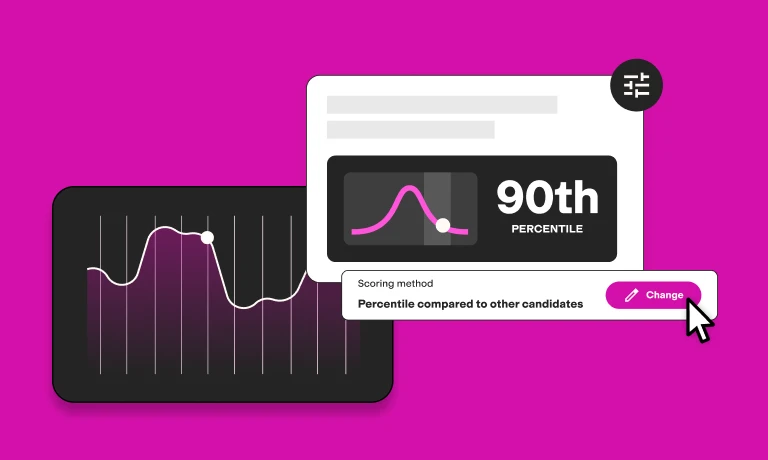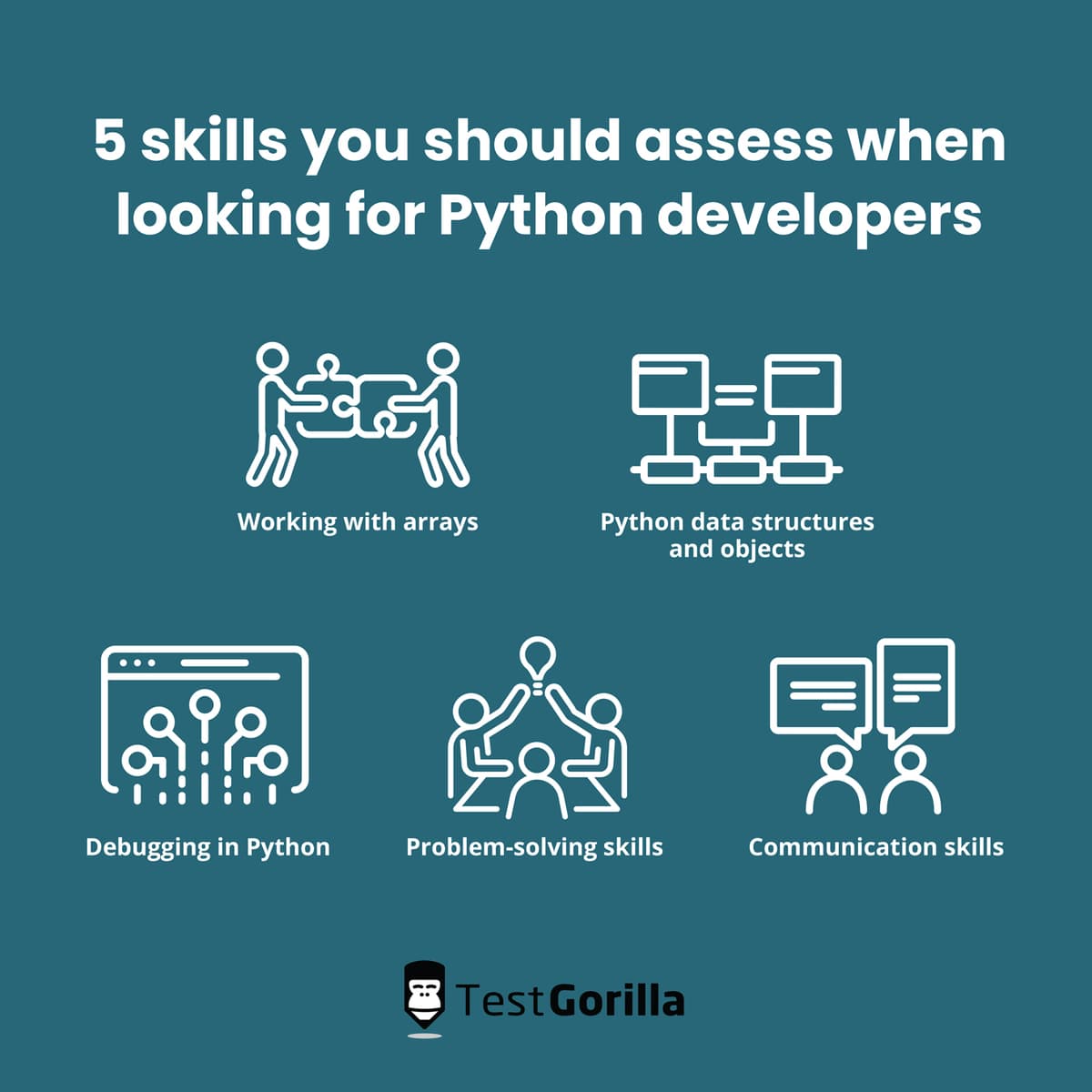45 arrays in Python interview questions
Finding a Python programmer who has the right knowledge to work with arrays in Python isn’t easy. You’ve got to assess their technical proficiency and their soft skills.
Wouldn’t it be handy if you had an easy way to objectively evaluate your candidates’ full range of skills?
We have good news for you – you can!
All you need is an efficient interview process with the suitable arrays in Python interview questions and skills assessments, and you’re all set.
We’ve got the ideal interview questions about arrays in Python listed below, along with some handy tips on skills testing in this article, so read until the end to make complex hiring processes a thing of the past.
Table of contents
- 14 general arrays in Python interview questions
- 5 general arrays in Python interview questions and answers
- 17 arrays in Python interview questions about definitions and processes
- 5 arrays in Python interview questions and answers about definitions and processes
- 14 situational interview questions about arrays in Python
- 5 situational interview questions and answers about arrays in Python
- Should you use skills assessments when evaluating applicants’ proficiency in Python, and when?
- 5 skills you should assess when looking for Python developers
- Find the best Python developer for your team with the right interview questions about arrays in Python
14 general arrays in Python interview questions
Ask your applicants these 14 general interview questions about arrays in Python to determine whether they have the basic knowledge and skills required for your role.
Explain how arrays are different from lists in Python.
What are the advantages of NumPy arrays compared with lists?
What is NumPy?
Why do developers use NumPy?
What is an array?
Which skills are required to use arrays in Python?
Describe your experience using arrays in Python.
Why are soft skills critical when using arrays in Python? Give some examples.
Explain what type codes are.
Explain what a dynamic array is.
Explain what a basic array is.
Explain what a sparse array is.
Explain what an associative array is.
Explain what an indexed array is.
5 general arrays in Python interview questions and answers
Here are five sample answers of the five most important general arrays in Python interview questions above to help you evaluate the depth of your applicants’ knowledge.
1. Which skills are required to use arrays in Python?
Candidates who are confident with Python should know that having a working knowledge of algorithms is crucial for using arrays in Python. Your applicants may also mention that understanding Python libraries and frameworks are also vital.
2. What is NumPy?
Can your applicants explain that NumPy is a package used with Python to process arrays? Are they aware that the NumPy package provides multidimensional array objects and facilitates working with arrays due to its high-performance mathematical functions?
3. Why are soft skills critical when using arrays in Python? Give some examples.
A Python developer should recognize the importance of soft skills when using arrays in Python.
For instance, excellent communication skills are required to work in Scrum teams when using Python, and problem-solving skills are critical for implementing array-supported algorithms.
4. Explain what a sparse array is.
Can your applicants explain that sparse arrays are types of data arrays that contain many elements with a value of zero? Applicants may also clarify that sparse arrays are the opposite of dense arrays, in which the majority of elements are full or have non-zero values.
5. Explain what a dynamic array is.
Applicants should know that dynamic arrays are arrays that developers can dynamically modify at runtime to adjust their size. Candidates should also know that developers do not have to specify the array size before the runtime.
The best insights on HR and recruitment, delivered to your inbox.
Biweekly updates. No spam. Unsubscribe any time.
17 arrays in Python interview questions about definitions and processes
Ask applicants some of these 17 arrays in Python interview questions related to definitions and processes to gauge the depth of their skills and knowledge.
Outline what ndarray is in NumPy.
How is ndarray different from an array?
Define vectorization in NumPy.
How is a NumPy array different from matrices?
How is vectorization different from broadcasting in NumPy?
Explain what meshgrid does in Python.
Explain what slicing does to an array.
Explain what an index number is for arrays.
Explain what the append() method does to arrays when using NumPy.
Explain what the clear() method does to arrays when using NumPy.
Explain what the copy() method does to arrays when using NumPy.
Explain what the count() method does to arrays when using NumPy.
Explain what the extend() method does to arrays when using NumPy.
Explain what the index() method does to arrays when using NumPy.
Explain what the pop() method does to arrays when using NumPy.
Explain what the remove() method does to arrays when using NumPy.
Explain what the sort() method does to arrays when using NumPy.
5 arrays in Python interview questions and answers about definitions and processes
Here are the sample answers to five of the most important arrays in Python interview questions about definitions and processes to help you assess the thoroughness of your applicants’ responses.
1. Explain what the count() method does to arrays when using NumPy.
Can your applicants explain that when using NumPy, the count() method will return the number of elements that have the value the developer has specified?
2. Explain what the extend() method does to arrays when using NumPy.
Applicants should be able to explain that when they use NumPy, the extend() method enables them to add list elements to a current list’s end.
3. Explain what the index() method does to arrays when using NumPy.
If your candidates are familiar with arrays in Python, they should know that the index() method will return the first element’s index that has the value they have specified.
4. Explain what the pop() method does to arrays when using NumPy.
Applicants should understand that when using a NumPy library, the pop() method will remove the element located at the position the developer specifies.
5. Explain what the remove() method does to arrays when using NumPy.
If your applicants can use arrays in Python confidently, they should know that the remove() method will remove the first item that has the value they have specified.
14 situational interview questions about arrays in Python
Ask your applicants these 14 situational interview questions about arrays in Python to determine whether their responses to complex situations match your requirements.
How would you reverse an array’s order in Python?
How would you determine the length of an array in Python?
Which approach would you use to add a value to a Python array?
Which approach would you use to remove a value from a Python array?
How would you make a 1D array?
How would you access items in an array?
How would you search for elements in arrays?
How would you update an element in an array?
When would you use the for in loop with arrays?
Which approach would you use to insert elements at the end of an array?
Which approach would you use to merge two arrays into one sorted array?
Which approach would you use to use one array to implement three stacks?
Which approach would you use to find the element that has the highest frequency?
Which method would you use to add numbers using recursion?
5 situational interview questions and answers about arrays in Python
Here are the answers to five of the above situational interview questions about arrays in Python.
Use these as a guide when evaluating your applicants’ responses.
1. How would you reverse an array’s order in Python?
Developers should understand that if they need to reverse an array’s order, they can use the [::-1] function, which will reprint ordered data structures and provide a reversed copy.
2. How would you determine the length of an array in Python?
Applicants who fully understand how to use arrays in Python should know they can use the len() function if they need to determine the length of an array. Applicants may give a code sample such as the following to fully explain this method:
xyz=’ABCD’
len(xyz)
Output = 4
3. Which approach would you use to remove a value from a Python array?
Knowledgeable applicants should know that there are two methods for removing a value from a Python array. They can either use the pop() function or the remove() function, but there is a difference between these methods.
Whereas pop() will return the value that the developer deletes, the remove() option will not.
4. Which approach would you use to add a value to a Python array?
Can your applicants explain the three main options to add a value to a Python array, which includes using append(), insert(i,x), and extend() functions?
5. When would you use the for in loop with arrays?
Applicants should understand that if they need to loop through every element that an array contains, they can use the for in function. They may also explain that for in loops are different from while loops and mention that while loops permit programmers to repeat statements for a TRUE condition.
Recommended reading: 16 basic Python interview questions (and answers)
Should you use skills assessments when evaluating applicants’ proficiency in Python, and when?
Pre-employment skills assessments help HR professionals determine whether applicants have a range of skills required to perform well in an open role, and can be an excellent way to complement interviews.
Assessments also make filtering out unqualified applicants a breeze and help you evaluate each candidate’s skills objectively.
It’s best to administer a skills assessment to all candidates right after you receive their applications. Skills tests enable you to quickly identify the best talent and make a selection of the candidates you want to invite to an interview. This facilitates the selection process and helps you save precious time.
Skills assessments can even give you ideas for the interview and help you build an effective training program for new hires based on any eventual skills gaps.
5 skills you should assess when looking for Python developers
Five essential skills you should assess when looking to hire your next Python developer include knowledge on working with arrays, Python data structures and objects, and debugging in Python, along with excellent problem-solving, and communication skills.
Here’s more on each of these.
1. Working with arrays
Working with arrays is a critical skill for Python developers.
Understanding how to create algorithms when working with arrays is one sub-skill that applicants should have, and they should also have experience working with many variables without complications. Do your applicants understand what arrays do and why they are essential?
2. Python data structures and objects
Your candidates should know why data structures and objects are vital for working with arrays in Python. They should know how to use data structures and objects and be able to explain their advantages (including managing and organizing data).
Recommended reading: 3 crucial levels of competency in Python and the best ways to assess them
3. Debugging in Python
The debugging process is essential for programming in Python.
Do your applicants understand what debugging in Python requires and why it’s crucial? Can they fix scripts that have errors, and can they find ways to collaborate with other Python developers to review code efficiently?
Recommend reading: 25 Python debugging interview questions
4. Problem-solving skills
Problem-solving is a critical soft skill for Python developers. Can your applicants understand a given problem, determine which solution will work best, and adapt to challenges and obstacles when coding in Python? Can they write the required syntax for each algorithm in a way that facilitates the problem-solving process?
5. Communication skills
Since your applicant will most likely be working in a team, communication and collaboration are two crucial soft skills that can facilitate programming with other team members.
Code reviews and debugging, for instance, will require developers to make comments and share ideas to make progress as a team.
Find the best Python developer for your team with the right interview questions about arrays in Python
It’s tricky to find an excellent Python developer with the soft skills that match the role’s requirements and the technical aptitude that meets your expectations, but now you’ve got the secrets to hiring top talent.
Start the process with skills testing. This method will help you automatically identify qualified applicants with the soft skills and technical proficiency required for your open role.
Follow up with an in-person or video interview process, with the suitable arrays in Python interview questions, and you’ll find hiring effortless. You can also see more questions in our list of 100 Python interview questions.
Use skills tests and the right interview questions to make hiring easy and find excellent Python developers for your team. Get started for free today and start making better hiring decisions, faster and bias-free.
You've scrolled this far
Why not try TestGorilla for free, and see what happens when you put skills first.


